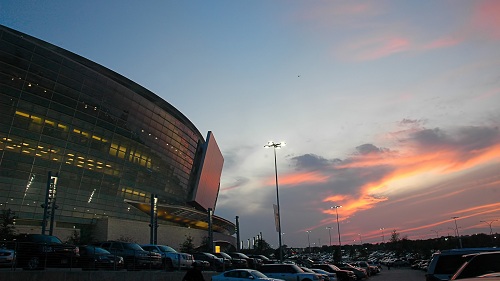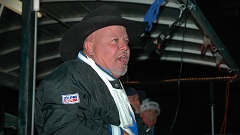Austin at SXSW 2012: Jonny Mars, 'America's Parking Lot'

Austinite Jonny Mars may be best known for his roles in front of the camera in Texas independent films such as The Happy Poet and Wuss, but he's also spent a considerable amount of time over the last five years behind the camera directing his first film project, America's Parking Lot. In this documentary, Mars captures the story of Cy Dittmore and Stan "Tiger" Shults, two die-hard fans of "America's Team" and leaders of the legendary Gate 6 tailgate party, as they spend their last season with the Dallas Cowboys at the historic Texas Stadium. The economics and politics within the NFL threaten to dissolve the friendships and traditions these blue-collar tailgaters have built over 20 years.
I spoke recently with Jonny Mars as well as America's Parking Lot editor Robin Schwartz and sound engineer Eric Friend to discuss their film, which debuts at SXSW 2012 on Sunday afternoon.
Slackerwood: Describe America's Parking Lot in a few sentences.
Jonny Mars: Effectively America's Parking Lot chronicles the journey of two tailgaters as they move from their old stadium and 25-year-old tradition to a new billion dollar stadium, as they try to hold on to their tailgating tradition as well as their friends and identity over a four-year period.
What was it that drew you to this film project?
Mars: Literally, sort of a bar bet. I've always said that football is better on television -- it's just easier to watch. I've been to games before, I'd just never been to a Dallas Cowboys game. I had this long-running bet with my friend who said, "You need to go, you're not doing it right," so finally I said, "Okay, well ... take me!"
So he got a ticket and took me three or four hours early and went to all these tailgates. And then he took me to Gate 6 and I saw this tailgate that just blew my mind. They had already announced that they were moving the stadium so I knew that this thing was going to go away. I had kind of been looking for a project to direct, and it just seemed like a story to tell. Had everything that you would be looking for -- interesting characters, you knew there was conflict on the horizon, and I knew where they were going to be every Sunday, ten Sundays of the year. I would always have access to them if they granted it.
Have you always been a football fan? Has this film project changed your attitude towards football?
Mars: Yes -- I enjoy sports, and I definitely enjoy fandom. This was a love letter in a way to the fans of all sports, as the economics of the world change so to speak. Football is not my favorite sport, though.
Slackerwood: Can you talk more about the economic background of this story and the personal seat licenses (PSLs)?
Mars: I find personal seat licenses interesting. The more I dug into this story of how they were going to build this stadium and how it was going to affect the fans, the more I was introduced to something that I had never heard of called a PSL. I thought it was just fascinating and it had been around so long -- I think 1996 was the first time that they instituted in the NFL. The anecdote goes that it started in college NCAA tennis, in 1986, as a way to get boosters to pay more money and finance a new stadium. It was something that I came across that I didn't know existed, and I was fascinated by it -- upon further research, I realized that the amounts that they were asking for some of the Dallas Cowboys PSLs were astronomical and unheard of. You could see that in the reaction that the fans were having in the parking lot. We gotta tell this story, not even that it's the actual villain, but it's definitely a great foil to get some true emotion out of the fan base.
It needed to be explained, and I think it's something that is a crazy side of capitalism gone unchecked and unbalanced. It's kind of unfair -- yeah, if the market demands it people will pay it. It's really hard to explain, and that was one of the challenges for people to understand it. I think that's why so many reporters speak to it. We went back and actually interviewed more reporters to get them to explain. It's something that doesn't make sense. I'm conflicted about PSLs for several reasons.
How in editing did you choose to depict the contract between the game environment for the Dallas Cowboys fans versus the Green Bay fan base?
Robin Schwartz: I think that what we realized pretty quickly was that in order to make the story speak to a broader audience and to make it real to everyone -- not just Texans, or Cowboys fans -- but to put it within a national context, we had to go out to Green Bay, and to the Giants. We didn't necessarily start out trying to make Green Bay the capstone of the story, but it unfurled that way. As we were building the struggles of the Cowboys fans and as we added the Giants and were pulling in all these elements, Green Bay just naturally fit. They were the counterpart to what the Dallas Cowboys were saying, and the Green Bay fans said it so eloquently and it was really beautiful.
Mars: And Green Bay's Lambeau Stadium is the oldest stadium now -- Texas Stadium was the second oldest and it's not anymore. Lambeau Stadium is the last living example of how it used to be. Now the second oldest one is Arrowhead, and I think that time is ticking on that as well.
What was it like shooting the emotional scene of the final tailgate party at Texas Stadium?
Mars: That was easy to overcome -- the temperature dropped 80 degrees that day, and no one was prepared for it. Myself and producer Jason Wehling had a group with five cameras out there. We sent the first wave back to Austin, because we had to hang out and get the end of the game but we didn't need everyone.
As they were leaving, it was literally 30 degrees and the wind was howling. We didn't have any clothing to be prepared for the weather. We just had to get the shot, and it was really easy not to get wrapped up in the emotion once the temperatures dropped. At the same time like, it was a crazy scene out there. The movie was always on my mind before, it being the last thing. but i definitely knew that we were part of something historical. When it's 20 degrees below zero, and you are in short sleeves -- we couldn't feel our fingertips for four months after that game. There were a few times watching the guys get really upset, you might well up -- but it's just sports, it's not life or death for me.
Why should people see America's Parking Lot, especially people who may think that they have a disconnect from football fandom and tailgaters?
Mars: I think that this movie is about family. I've been thinking about this a lot, and as I watch it more and more, I see two guys that are defining family. There are a lot of things going on in this story, but the last few weeks for me this film was about what is a family and outside elements that can affect it. You can drop plenty of parallels and metaphors into that, but these guys are human.
We went a really long way to try to not make fun of them, and I hope that we didn't. That was never the goal, and I think that they are real people, interesting. I think that they are very honest, inviting and endearing people and were very gracious to me. I want to present them as real 3-D human beings So for this last week, the film is about what is family, and how it affects you if someone tries to take it away from you, what do you do? It's the heads of two families struggling to get back together to reunite on a new block.
You've been following this story since 2006 -- what made you decide to finally wrap America's Parking Lot?
Jonny Mars: You spend five years on something, it's time to sew it up. I don't know that there was much more story to tell. There was a great ending in Green Bay playing the Superbowl at Jerry Jones's (Dallas Cowboys owner) stadium, and they won. That's the button in a lot of ways. The Packers were in the playoffs again this year on the way to another Super Bowl, and I was really hoping that they wouldn't because that could have potentially extended the movie for another beat. It was time to end it for the most part. The plan was always to definitely shoot the last 15 games at the old stadium, and shoot as many games as possible at the new stadium in Arlington and see what we had. The story unfolded and we just had to tell it.
Why did you choose to focus on Cy and Tiger?
Mars: When my friend took me to their tailgate, it's Cy and Tiger's party so obviously they get all the attention. As we were shooting this film, there were a handful [of people] that I followed a little bit, but they never really developed. Nothing as interesting as what Cy and Tiger do.
At the end of the day, I always knew that this doc had process. I'm interested in process, I think it's an easy thing to hang your hat on as a storyteller. I'm an actor and process is a big part for me in building a character.
There were other fans that we followed but even as we were out in the parking lot, they didn't have as much going on as these two guys in terms of a) process, just things that they were doing that were cinematic, and b) the passion that these two individuals had for their team and what their position was in that parking lot. They're the alpha dogs, and doing their thing on camera is always going to win. At the end of the day, we always knew that we could hang our hat on those two guys.
Honestly, who is this movie about? As the years went on, is it Cy's story, is it Tiger's story? I think that's debatable. Yes, there are other people we followed, but no one rose to the top like those guys did. They had and have a very specific thing that they offer to a group of people outside the stadium where the Dallays Cowboys play. And that really shined on camera.
Slackerwood: What other projects do you have at SXSW 2012?
Mars: I'm in a short film called Hellion that Kat Candler directed. I make an appearance in Bob Byington's movie, Somebody Up There Likes Me. I'm also in a few bumpers that Eric Friend mixed. Eric is the indie film slut -- he did Bob's movie, Taiwan Oyster, the bumpers, Hellion and Slacker 2011.
Slackerwood: Any final words on America's Parking Lot?
Mars: Please allow me to thank Arts and Labor who were very, very generous in giving this project a home for a long time. Alan Berg and Craig Parks and everybody over there have been awesome for allowing us to exist for the amount of time that it has taken for this film to finish and get a life. They foster the scene definitely, but they are instrumental in a lot of ways for this project to even have legs. It's a very vibrant community within those walls. You don't have to go far to get a question answered, and you don't have to go far to get some creative inspiration either.
Find out more about America's Parking Lot on their website. Screenings for America's Parking Lot on SXSW Schedule:
- Sunday, March 11, 2 pm, at Canon Screening Room
- Monday, March 12, 5 pm, at SXSatellite: Alamo Slaughter
- Wednesday, March 14, 4:45 pm, at Alamo Lamar C
- Saturday, March 17, 11 am, at Alamo Lamar B
[Photo credits: "Texas Stadium at Sunset," "Cy in his Trailer," courtesy of Jonny Mars]

